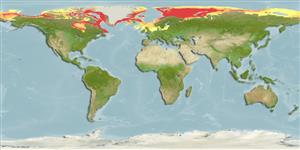Preferred temperature (Ref.
123201): -1.3 - 4.6, mean 0.2 °C (based on 3829 cells).
Phylogenetic diversity index (Ref.
82804): PD
50 = 0.5000 [Uniqueness, from 0.5 = low to 2.0 = high].
Bayesian length-weight: a=0.00776 (0.00450 - 0.01340), b=3.19 (3.04 - 3.34), in cm total length, based on LWR estimates for this species & (Sub)family-body (Ref.
93245).
Trophic level (Ref.
69278): 3.1 ±0.35 se; based on food items.
Resilience (Ref.
120179): Medium, minimum population doubling time 1.4 - 4.4 years (Preliminary K or Fecundity.).
Fishing Vulnerability (Ref.
59153): Low vulnerability (10 of 100).
Nutrients (Ref.
124155): Calcium = 67 [25, 167] mg/100g; Iron = 0.491 [0.206, 1.230] mg/100g; Protein = 16.3 [14.1, 18.5] %; Omega3 = 0.407 [0.152, 1.269] g/100g; Selenium = 17.8 [6.1, 46.0] μg/100g; VitaminA = 21.2 [4.2, 104.9] μg/100g; Zinc = 0.671 [0.402, 1.188] mg/100g (wet weight);
